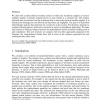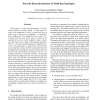2522 search results - page 18 / 505 » From Self-Organized Systems to Collective Problem Solving |
GECCO
2006
Springer
13 years 11 months ago
2006
Springer
The application of network analysis to emergent mating topologies in spatially structured genetic algorithms is presented in this preliminary study as a framework for inferring ev...
GECCO
2010
Springer
14 years 10 days ago
2010
Springer
The Spidergon interconnection network has become popular recently in multiprocessor systems on chips. To the best of our knowledge, algorithms for collective communications (CC) h...
COR
2010
13 years 7 months ago
2010
We deal with a multi-echelon inventory system in which one warehouse supplies an item to multiple retailers. Customer demand arrives at each retailer at a constant rate. The retai...
SASO
2008
IEEE
14 years 1 months ago
2008
IEEE
In this paper we study desynchronization, a closelyrelated primitive to graph coloring. A valid graph coloring is an assignment of colors to nodes such that no node’s color is t...
SASO
2008
IEEE
14 years 1 months ago
2008
IEEE
—When programming a spatial computing medium such as a cellular automaton, the hop count distance to some set of sources (particles) is an often used information. In particular, ...


